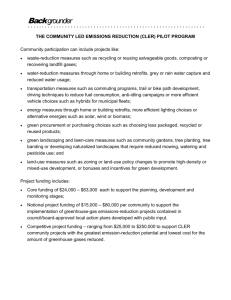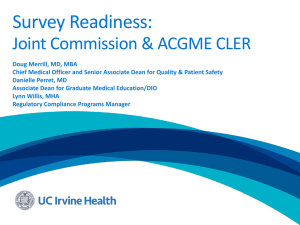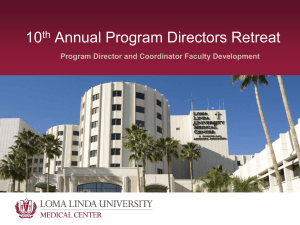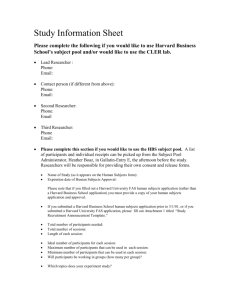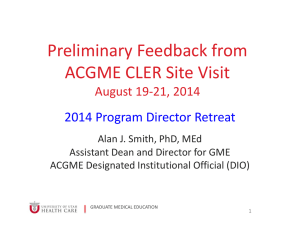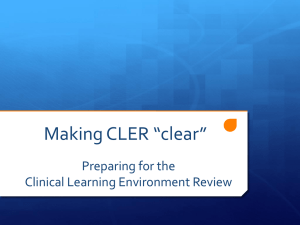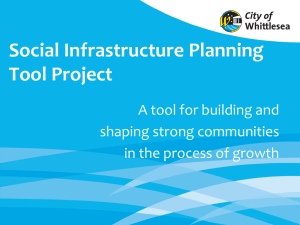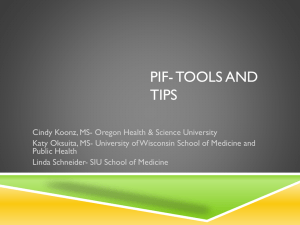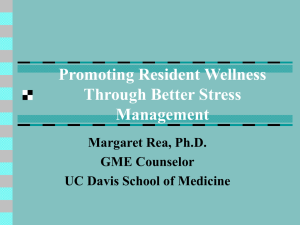I`m CLER, We`re all CLER - Graduate Medical Education
advertisement
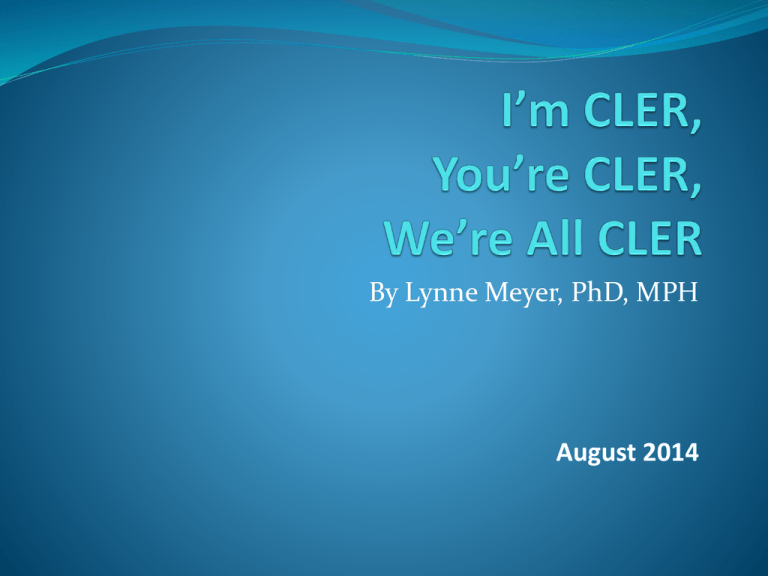
By Lynne Meyer, PhD, MPH August 2014 What is CLER? CLER Site Visits are required by the ACGME every 18 months (similar style to JCAHO) Focuses on the learning environment, not just the residency program Focuses on Patient Safety, Quality, Health Care Disparities, and more Effective July 2013 for all ACGME-accredited programs The Big Picture: Resident, Faculty, Program and Institution Reviews Review of Program Personnel Review of Program Institutional Review Every 6 months: SemiAnnual Review of Residents Once a year: Review of Program by Program Evaluation Committee (PEC) Every 18 Months: Clinical Learning Environment Review (CLER) Once a year: Review of Faculty Once a Year: Review of Program by ACGME Review Committee PRN: Progress Reports, Focused or Full Site Visits as determined by Review Committee based on data review Every 10 Years: Self-Study Visit CLER Site Visit Components: Meetings and Walk Arounds Meet with: Senior Leadership Quality and Safety Leadership Residents/Fellows Core Faculty Program Directors Walk Arounds to check on 6 focus areas for CLER Who’s involved? EVERYONE Program Directors Faculty Resident/Fellows Hospital Administration Nurses/Technicians/Pharmacists, etc. CLER Site Visit Information SHORT NOTICE: 10 days to 3 week notice Visits will last 2-5 days (probably 2-3 days) Our 1st CLER visit will only be used for feedback and baseline data CLER’s 6 Focus Areas Patient Safety Quality Improvement (including Health Disparities) Transitions in Care Duty Hours, Fatigue Management & Mitigation Supervision Professionalism CLER Focus Areas Integration of residents into institution’s Patient Safety programs, and demonstration of impact including opportunities for residents to report errors, unsafe conditions, and near misses, and to participate in inter-professional teams to promote and enhance safe care CLER Focus Areas Integration of residents into institution’s Quality Improvement programs and efforts to reduce Disparities in Health Care Delivery, and demonstration of impact including how sponsoring institutions engage residents in the use of data to improve systems of care, reduce health care disparities and improve patient outcomes Patient Handoffs: A Typical Day on the Wards http://www.youtube.com/watch?v=JzCdoQEYHkY What processes do you use to standardize and improve your handoffs CLER Focus Area: Hand-offs Oversight of Transitions in Care including how sponsoring institutions demonstrate effective standardization and oversight of transitions of care We will be implementing a standardized process CLER Focus Areas Oversight of Duty Hours Policy, Fatigue Management and Mitigation including how sponsoring institutions: (i) demonstrate effective and meaningful oversight of duty hours across all residency programs institutionwide; (ii) design systems and provide settings that facilitate fatigue management and mitigation; and (iii) provide effective education of faculty members and residents in sleep, fatigue recognition, and fatigue mitigation. CLER Focus Areas Establishment, implementation, and oversight of Supervision policies including how sponsoring institutions maintain and oversee policies of supervision concordant with ACGME requirements in an environment at both the institutional and program level that assures the absence of retribution Excerpt from Resident Survey CLER Focus Areas Education and monitoring of Professionalism with regard to how sponsoring institutions educate for professionalism, monitor behavior on the part of residents and faculty and respond to issues concerning: (i) accurate reporting of program information; (ii) integrity in fulfilling educational and professional responsibilities; and (iii) veracity in scholarly pursuits Excerpt from ADS Annual Update How would you answer these? What areas have the hospital identified as opportunities for improvement? What types of patient safety activities are you involved in? What is an RCA? Do you know how your individual QI and patient safety projects relate to the hospital’s overall plan? Have you reported Medical Errors, Unsafe Conditions, or Near Misses? What is the process for reporting Medical Errors, Unsafe Conditions, or Near Misses? How effective is the dialogue during hand-offs? How effective are educational efforts around sleep and recognizing and preventing fatigue? Is the level of supervision you experience adequate for your level of training? SV Components: Walk Arounds Possible Areas of Focus: Primary focus on hand-off for change of duty Check for variability in process and oversight of resident hand-offs Look for examples of both under and over supervision See if knowledge of need for direct supervision appears to be limited to GME faculty Look for consistent vs. variable evidence of effective management strategies for duty hours and fatigue management SV Components: Walk Arounds Walk arounds of patient floors, OR and clinics: need experienced chief or senior residents (PGY3 or higher) Random interviews of staff (e.g. nurses, techs, pharmacist): Talk with nurses Talk with other residents and physicians on units Possible patient contact May ask people encountered about their perspective of residents related to the six focus topics The CLER team will want to observe a handoff without supervision May return in the evening Accessing the PSR…. https://my.portal.shands.ufl.edu/portal/page/portal/SHCE MPAUTH After you log in, an express report is available Examples of Medical Errors Failure to employ indicated tests Error in the dose or method of using a drug Failure to provide prophylactic treatment Failure of communication Equipment failure Why Report Near Misses Not wait for harm to occur Trigger improvements in weak spots in the care process Alert others for possible vulnerabilities and training gaps Contribute to planning, recovery testing, harm mitigation strategies following events that do result in harm PDQ List https://intranet.ahc.ufl.edu/ForwardTogether/qualitycenter/Lists/PD Q%20List/AllItems.aspx CLER and our Focus on Patient Safety and Quality We need to role model and teach these concepts to our fellows, residents and medical students so they become a way of life. Documentation of CLER We must document what we teach, what we learn and outcomes for: Patient Safety Quality Improvement -- if on QI/PS project – document in New Innovations Transitions in Care – used a standardized process such as SBAR or IPASS Duty Hours, Fatigue Management & Mitigation Supervision Professionalism Do you use the PSR when indicated? Do you review the goals and objectives with your learners? Do you provide your learners with feedback? (formative) Do you return your evaluations on time with meaningful data/comments? (summative) Resources GME Housestaff: Housestaff Patient Safety and Quality Improvement Committee – Lee Titsworth, MD, Chair http://gme.med.ufl.edu/policy-procedures/patient-safety/ https://ufhealth.org/quality-and-patient-safety/welcome UF Health: Sebastian Ferrero Office of Clinical Quality and Patient Safety https://intranet.ahc.ufl.edu/ForwardTogether/qualitycenter/SitePages/Ho me.aspx Resources ACGME’s CLER Program http://acgme.org/acgmeweb/ Sites with Curriculum and Cases to work through AHRQ Patient Safety Network http://psnet.ahrq.gov/ AHRQ webM&M http://www.webmm.ahrq.gov/ VA National Center for Patient Safety http://www.patientsafety.va.gov/professionals/training/curriculum.asp Questions? lynnemeyer@ufl.edu 352-594-6226
